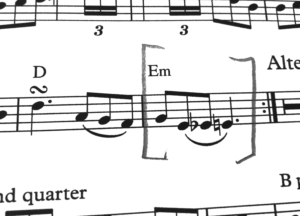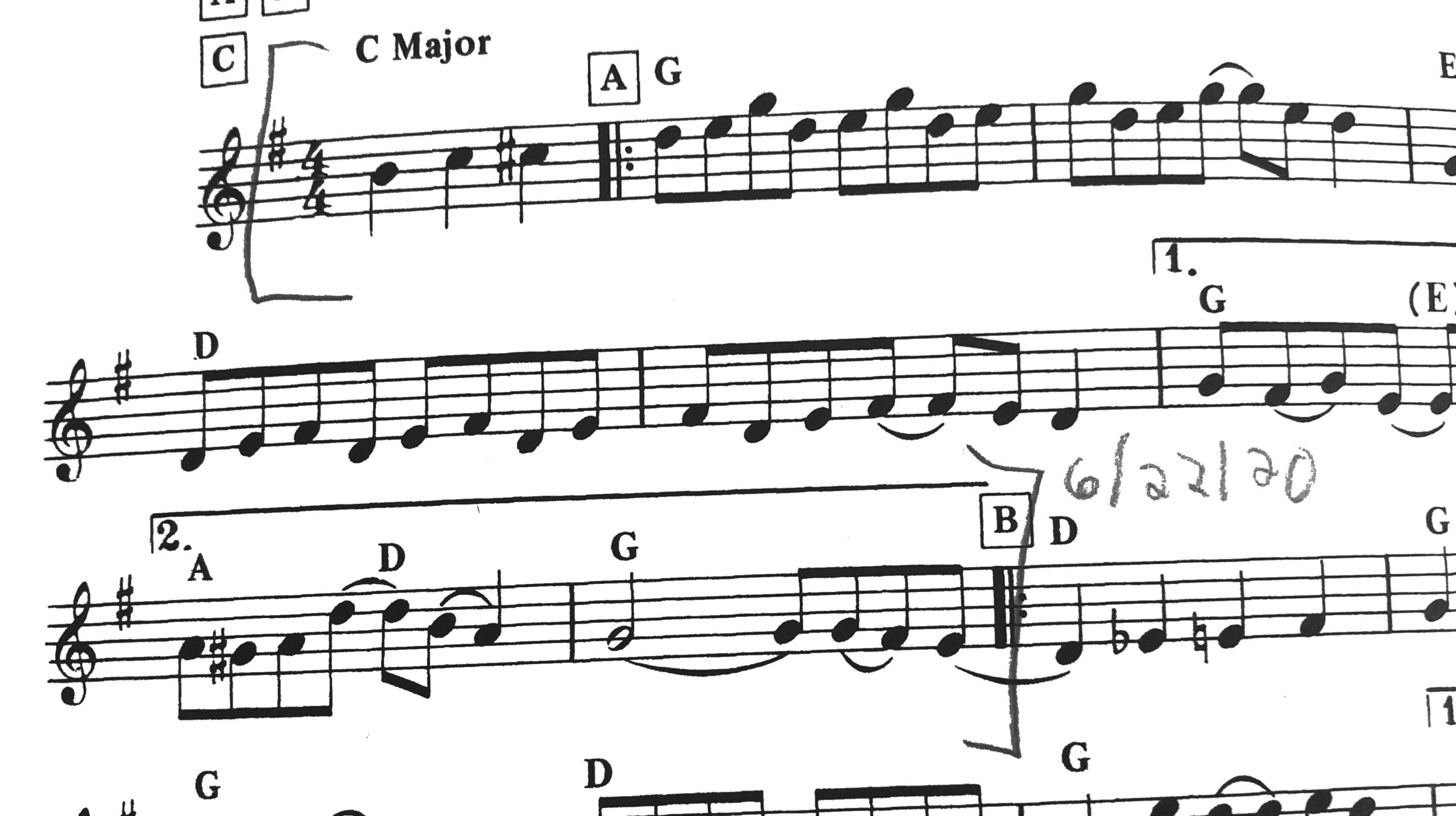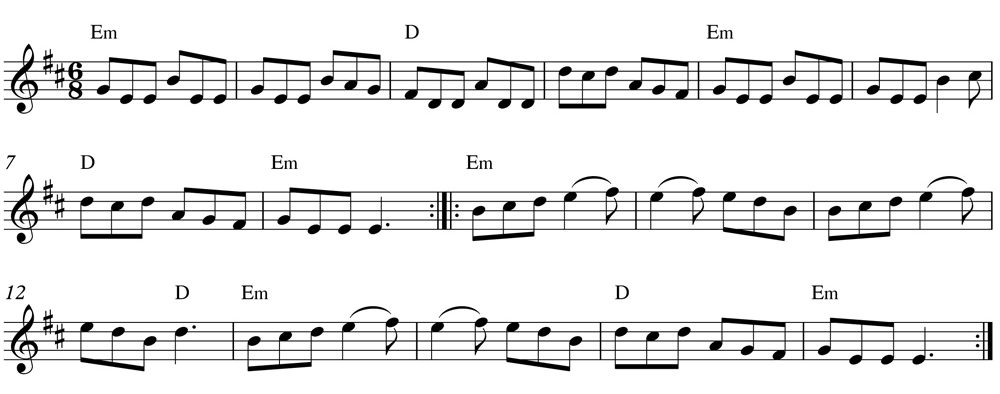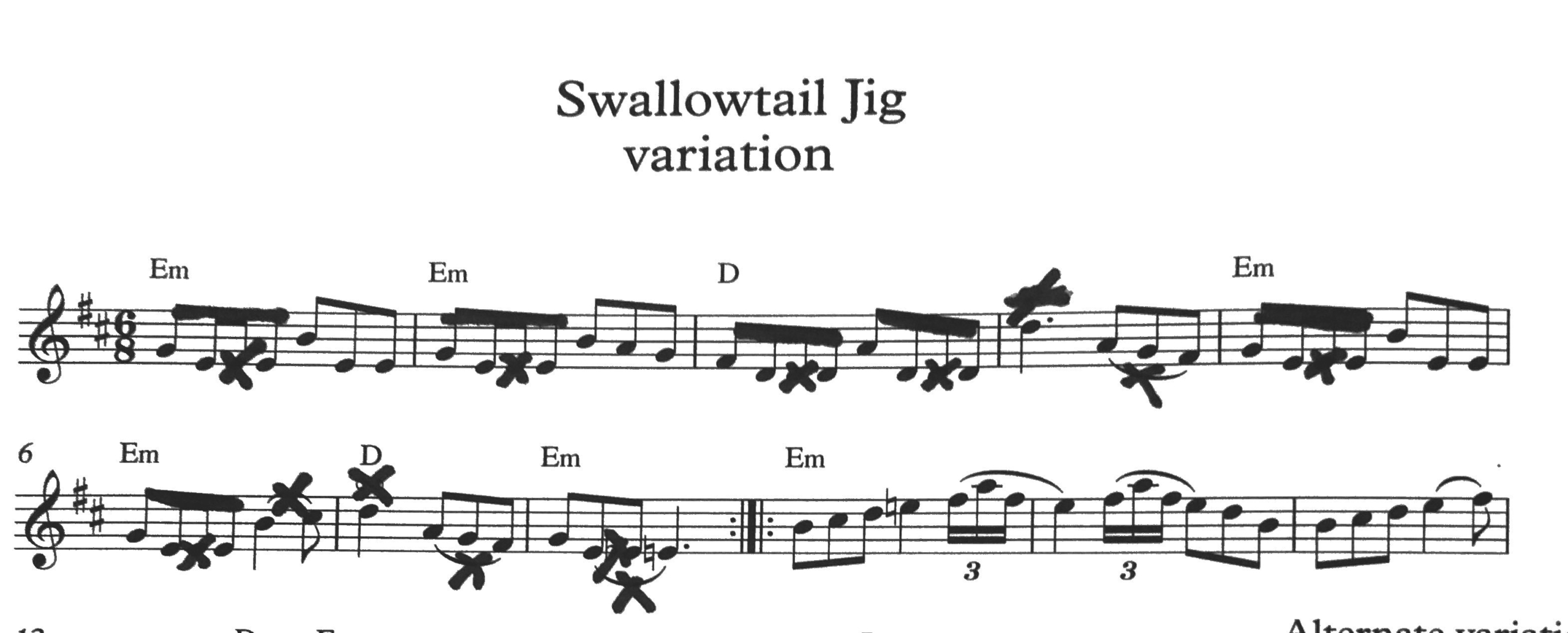Learning Fiddle Tunes From Sheet Music
There are two big things to keep in mind when learning tunes from sheet music.
- Play the scale
- Simplify
- Incremental learning
I’ll go more into this below. Just know that these are some of the basic tips and strategies I teach throughout the course: Micro-practice and Looping.
Learn tunes incrementally, just like in video lessons
Don’t try to read the entire tune when you first look at it. Learn it in small chunks, just like you would in one of my video lessons.
This applies to both beginning and advanced students. I’ve gotten pretty good at reading fiddle tunes. But once in a while, I’ll encounter something I can’t immediately play. So I take the incremental approach.
A fringe benefit of this approach: you are more likely to remember the tune.
Some steps for learning incrementally learning a tune from sheet music.
- What is the scale of the tune? Look at the key signature. Play that before you start to learn the tune. For the example above, the scale would be D Major. Warming up with that will help you to both read and play the tune. This practice also helps you to hear the music in scales.
- Don’t try to read the whole tune at once. Start with the first bar. When you think you have it figured out, check it against the audio (if available).
- If you’ve read it correctly, then slowly loop on that first bar. Use the three steps of the Intuitive Note-Reading process:
-
- Play without reading.
- Read without playing.
- Play and read at the same time.
- Do this with audio. Then do it without audio. More on INR: Intuitive Note-Reading.
- Look for repeating patterns. See if that first bar is repeated elsewhere in the tune. This will make the job of reading the rest of the tune much easier. Look at the sheet music for Bile ’em Cabbage Down. Where is the first bar repeated? Learn more about this: Finding Patterns In Sheet Music.
- Repeat this process for the second bar. When you can read it, play the first two bars. See if these two bars (usually the first quarter of the A part) are repeated anywhere.
- Bracket difficult parts with a pencil. Then the next day, you’ll know to spend more time practicing this. This is one of the great benefits to reading sheet music.

- For longer and more challenging tunes, note your progress.

Simplify as much as possible
I recommend starting to learn a tune with the simplest version possible. So if you have access to a basic version and a variation version, start with the basic version.
As you find sheet music for tunes you love, you’ll notice that there are bow markings and embellishments written in already. Even if you are fairly advanced, I recommend trying to strip all of this away, leaving the essential melody. There are two benefits to the minimalist approach:
- The tune becomes easier to read, learn, and memorize.
- You are not attached to a particular arrangement of a tune. This means that you can ultimately be more creative with how you add expression and variation to a tune.
Here are some ways that you can simplify tunes.
- Remove all slur markings.
- This is an easy step. Once you’ve learned the melody, go back and add the slur markings.
- Remove all embellishments: turns, grace notes, slides.
- Remove all double stops. If you’re a beginner, this may be less intuitive. You want to take away drone notes so that you can more clearly hear the melody. Again, just do this when first learning the tune.
- Remove 16th note duplets. This is also less intuitive.
- Ignore all dynamic markings (if you’re learning a classical tune). These are things that indicate changes in volume and tempo, like piano, forte, ritardando, diminuendo, etc.
Let’s take the A part of Swallowtail Jig as an example. Say you found it in the Irish Fiddle Journeys Book (this does not exist…yet 💭).
Swallowtail Jig – Variation

Though it looks like a lot of fun, don’t start with this, even if you’re an advanced player. Start by learning a very basic version of the tune:
Swallowtail Jig – Basic version

But sometimes this might not be possible. Perhaps you want to learn the tune but you can only find advanced sheet music (with embellishments). I recommend you take out your trusty pencil, and X out all extraneous things from the core melody. I did this for you below. (I used a pen because it makes the image more clear, but a pencil is better because you’ll be able to erase these markings later).
Swallowtail Jig – Variation, simplified for learning

Let me explain what I did.
- In the first bar, instead of playing two D1 sixteenth notes (a sixteenth note duplet), I just play a single eighth note. I do this same simplification in bars 2, 3, 5 and 6.
- I removed the turn over D3 in bars 4 and 7.
- I removed the slurs from bars 4, 6, 7 and 8.
- I removed the slide from bar 8 by removing the E flat and replacing it with E natural.
After doing all this, notice that it resembles the basic version pretty closely.
With practice, you’ll become better at simplifying written music. This will help you to become less attached to the notation so that you can be more expressive with the music.
A common pitfall for classical musicians is that they cannot play anything that is not precisely written down. This practice of simplification will help you to look deeper and hear the music beyond the symbols on the page.
Two ways I can help you level up your fiddling
- Sign up for the FiddleHed newsletter below.
- Sign up for the Free Two-week Trial. You’ll get full access to all courses and group lessons. Plus, I’ll send you some free lessons tailored to your current skill level.
Thanks for being here 🙏
Return to Fiddle Questions >>
Leave a Reply
You must be logged in to post a comment.

For me, reading is the quickest way to learn new music. I like to sight read through the whole piece, but slowly. This helps me learn the tune (if I don’t know it) and also learn to play it at the same time. If I find any particular measures hard I isolate those and loop until they are smoother, then I go back to working on the whole piece. It’s sort of a back and forth between macro and micro practice.
Once I can hear the piece in my head pretty well I alternate between playing with and without seeing the sheet music and playing without and without the backup track. For me these are all useful modes of practice. Playing without the sheet music or backup track helps me learn the piece by heart. Playing along with the backup track helps me to learn the piece by ear and also keeps my timing and rhythm honest and shows up places that need some extra work. Playing with the sheet music lets me hear the piece before I have learned it by heart which, for me, is faster than learning a totally new piece in segments, which I find hard because I don’t have the tune in my head yet so I have a hard time hearing how the segments go together.
Once I’ve learned the piece I like to play it with a drone to keep my intonation clean.
So, for me, fiddlehed has all the components I need to do this: the sheet music, the back-up tracks, drones, etc. It makes learning a real pleasure. Thanks!
Also, I’m thinking this idea of simplifying music also gives ideas of how to embellish by reversing the process! I’m looking forward to learning to embellish after I get a little further along…
Thanks for a great site!